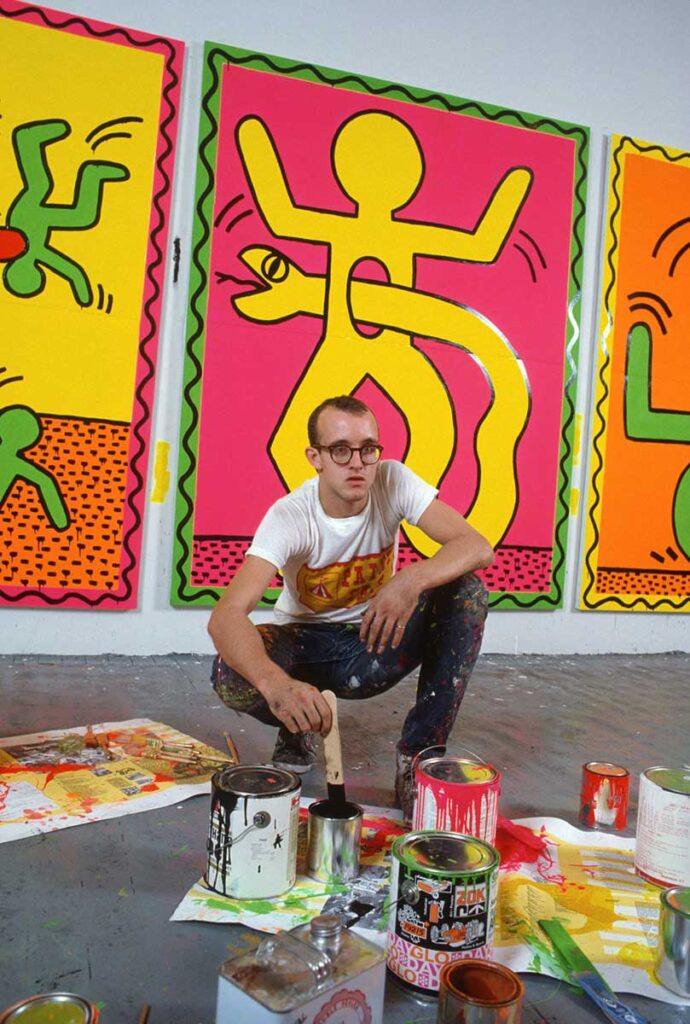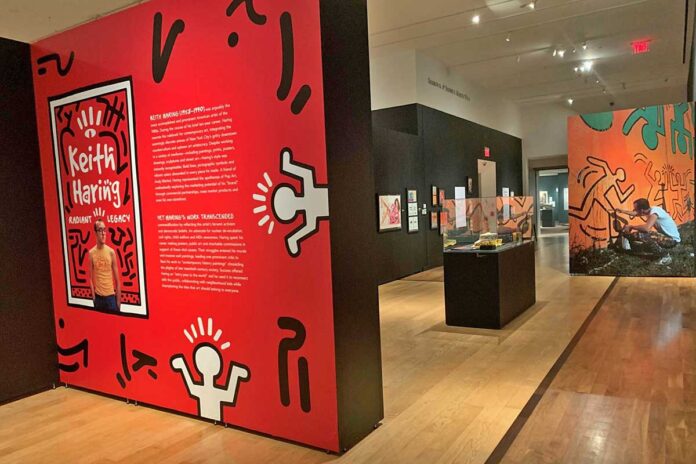Keith Haring, the openly gay artist whose work was ubiquitous in the 1980s, believed that art exceeded the limits of everyday experience.
“See, when I paint, it is an experience that, at its best, is transcending reality,” Haring told David Sheff, who interviewed him for the August 1989 issue of Rolling Stone.
“When it is working, you completely go into another place,” Haring said. “You’re tapping into things that are totally universal, of the total consciousness, completely beyond your ego and your own self.”
“Keith Haring: A Radiant Legacy,” a new exhibit at the James A. Michener Art Museum in Doylestown, offers a glimpse of this artistic universe, with its ecstatic imagery, squiggly lines, and eye-popping colors.

The exhibit, on display until July 31, includes more than 100 works created during Haring’s brief but prolific career. It includes everything from Haring’s most commercial work, like his Swatch watches, to deeply personal projects like “The Story of Red and Blue,” a whimsical storybook made for the children of his German art dealer.
Haring was a quintessential Downtown New York artist, but this exhibit emphasizes his roots in this region. Born in Reading on May 4, 1958, Haring was raised nearby in Kutztown. He described his upbringing as loving but conservative. Still, “Farmer Couple, Kutztown,” a simple black-and-white poster he made in 1989, reveals genuine affection for Pennsylvania Dutch Country.
In 1978, Haring moved to New York City to attend the School of Visual Arts. There, he befriended fellow artists Jean-Michel Basquiat and Kenny Scharf, worked as a busboy at Danceteria, and absorbed the influences of punk, rap, and graffiti.
On the subway one day, Haring had an epiphany: He noticed that expired ads were covered with black paper, an ideal space to draw. After buying chalk, he returned belowground and began the work that would make his name.
Haring did thousands of subway drawings between 1980 and 1985, according to an explanatory panel in the gallery. Two examples of these quirky, ephemeral images are on display. One depicts a television with wings on its sides and legs dangling below. It ascends out of reach of a slightly menacing figure that looks part animal, part human.
As Haring became better known, it became difficult to continue these subway drawings. So he shifted to billboards, walls, and other outdoor surfaces. His notoriety actually prompted invitations to paint murals, including a 1,000-foot section of the Berlin Wall that he painted in 1986.
Haring often made these murals with the help of local youngsters. A photograph of one, “We the Youth,” done in 1987, is on display. It can still be seen at 22nd & Ellsworth in Philadelphia. (It was restored by Mural Arts Philadelphia in 2013.)
No matter where Haring’s art appeared, his imagery was immediately recognizable. Barking dogs, flying saucers, and happy faces abound. An explanatory panel in the gallery describes them as “runic pictograms.” The exhibit also includes three large “Radiant Baby” posters, although viewers will spot that image throughout the show.
Haring’s art, with its bold lines and primary colors, was also easily reproduced. At the Pop Shop in Manhattan, which opened in 1986, he sold T-shirts, buttons, and other tchotchkes, some of which are on display. Haring was occasionally accused of crass commercialism, but he viewed the Pop Shop as a way of bringing affordable art to ordinary people.
With success, Haring’s art became increasingly political. He created work that addressed AIDS, apartheid, and crack. One example is “Crack Down,” a 1986 poster Haring created for an anti-crack benefit concert. It shows a large bare foot stomping down on a crack pipe, held aloft by two struggling figures.
Being a gay man was also integral to Haring’s art. Consider the two male figures hugging in the “Best Buddies” pieces, or the iconic lithograph, “Ignorance = Fear, Silence = Death,” which he created in 1989 to benefit ACT UP. Even more explicit is a series of six silkscreens called “Bad Boys.” Here, Haring’s bold black lines depict hard cocks, round buttocks, and men fucking.
Sadly, AIDS cut Haring’s career short. He died on February 16, 1990, at 31-years-old, after a decade of prolific work.
This exhibit, on view during a different epidemic, isn’t an exercise in mere nostalgia. Haring’s appreciation of beauty, his emphasis on pleasure, and his desire to bring art to ordinary people are refreshing given the stifling conservative atmosphere currently casting a pall over America.
To learn more about “Keith Haring: A Radiant Legacy”, visit: www.michenerartmuseum.org/.
